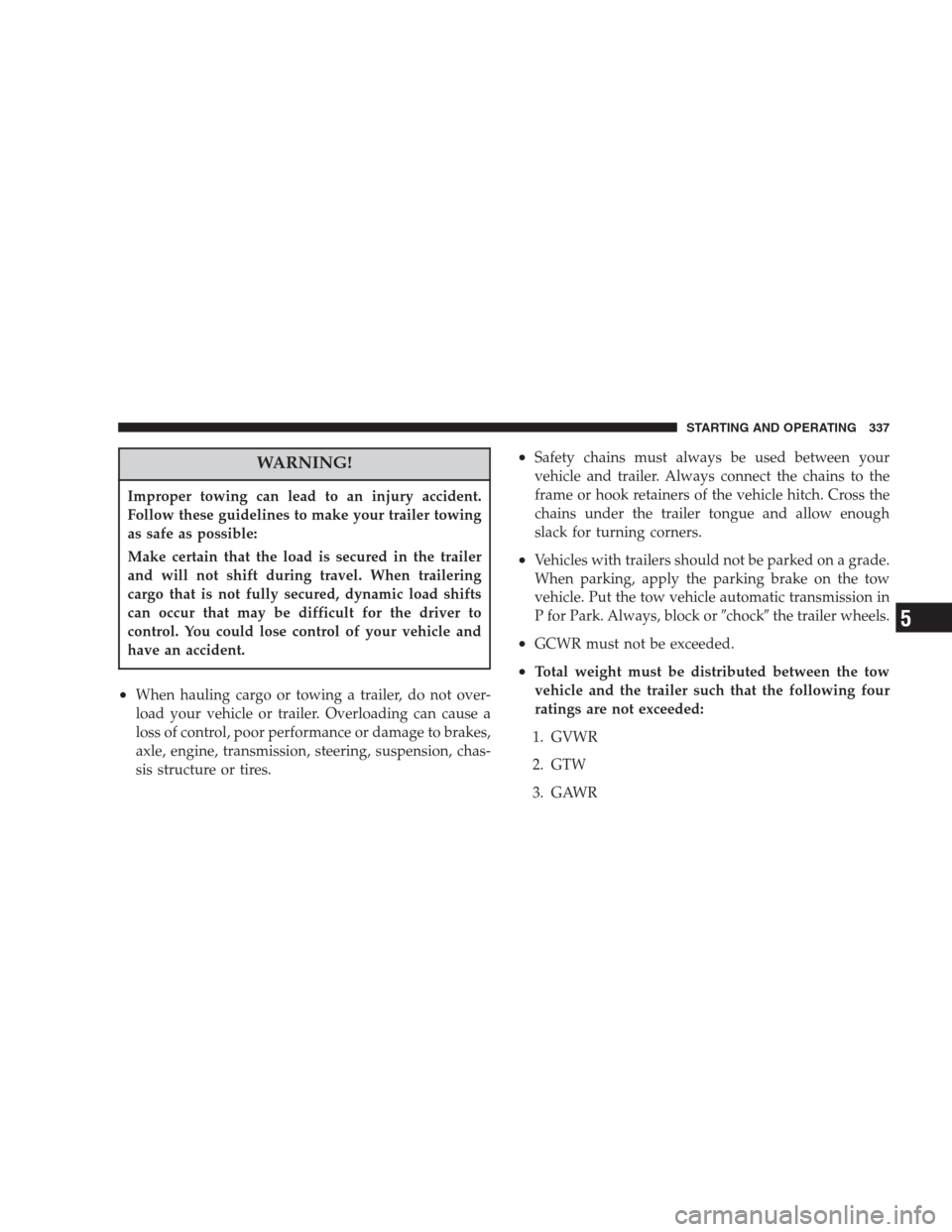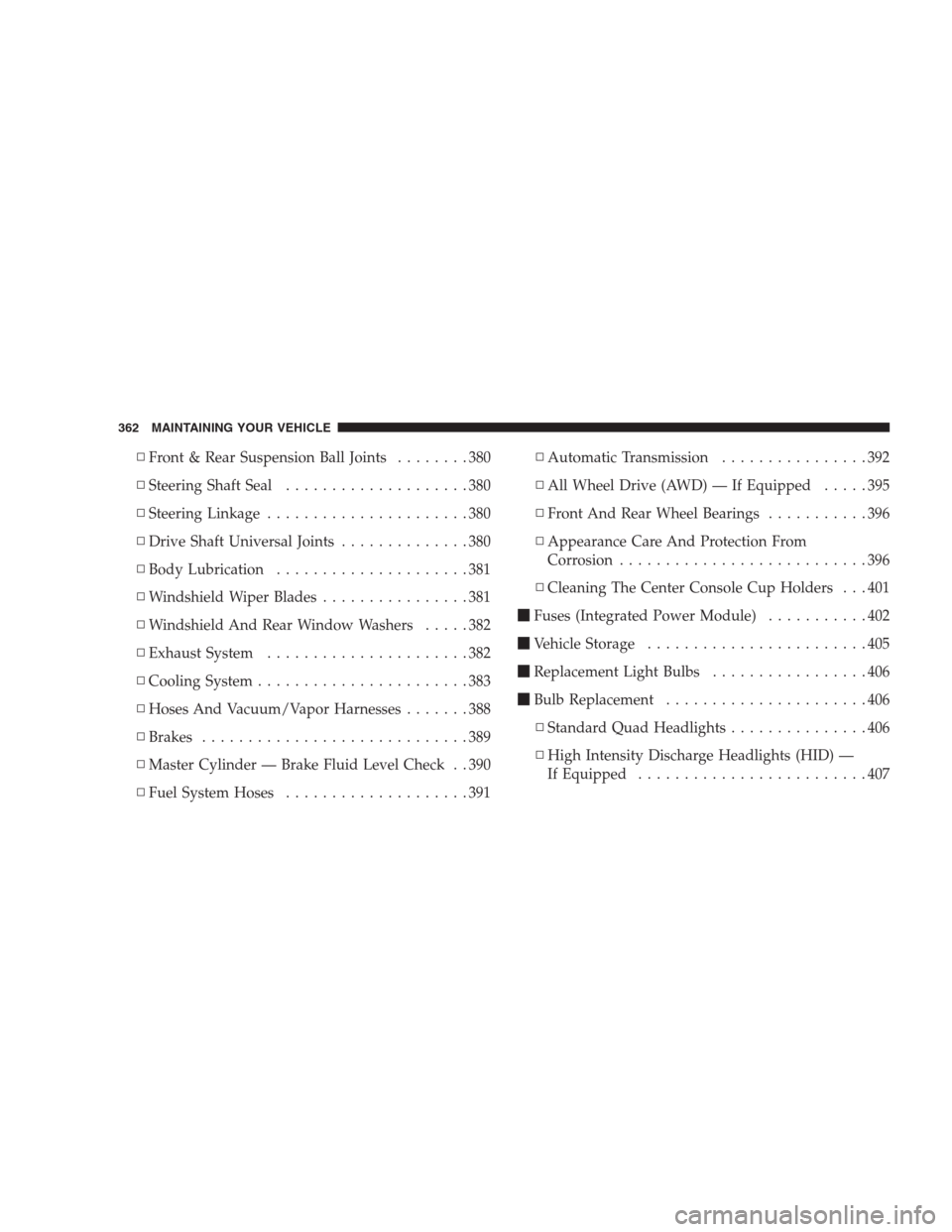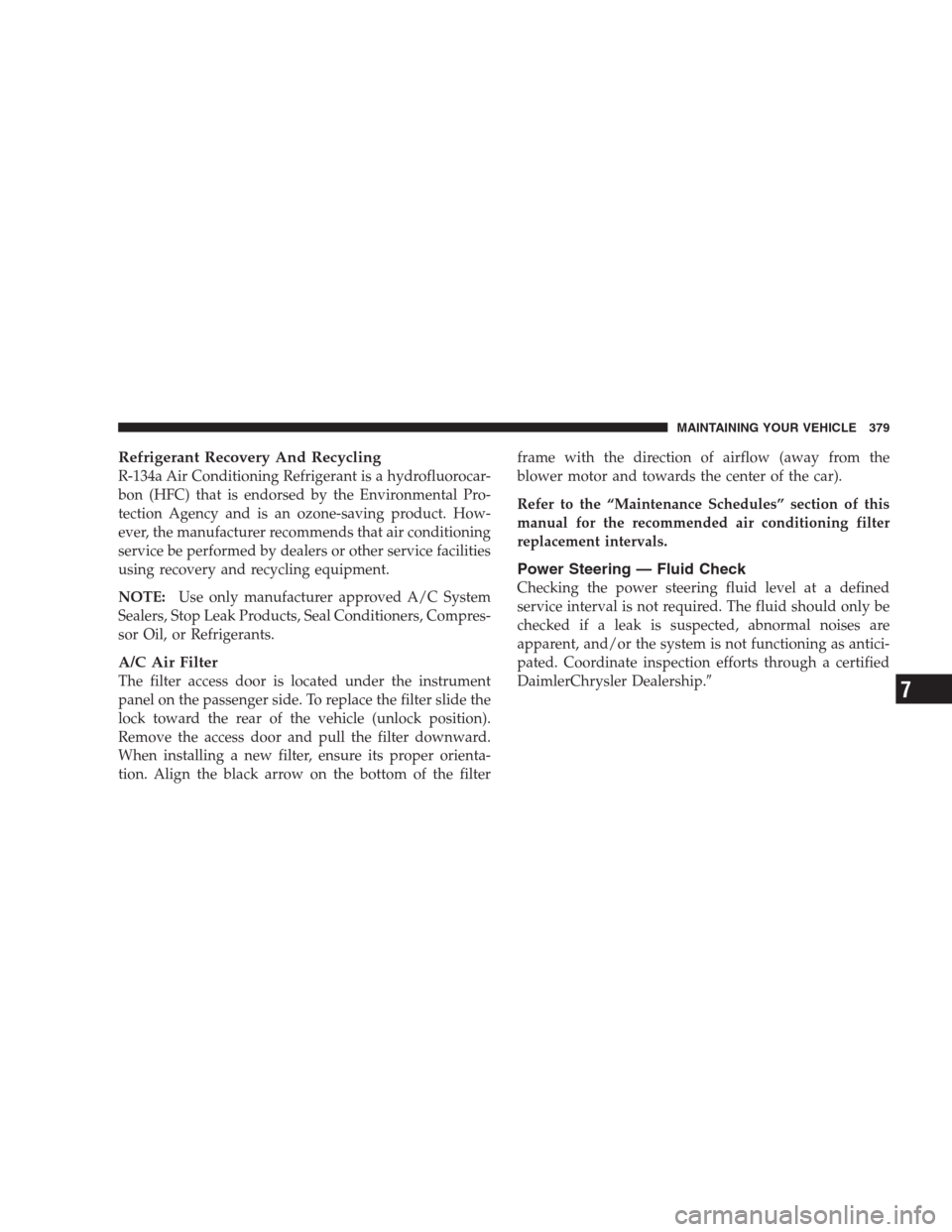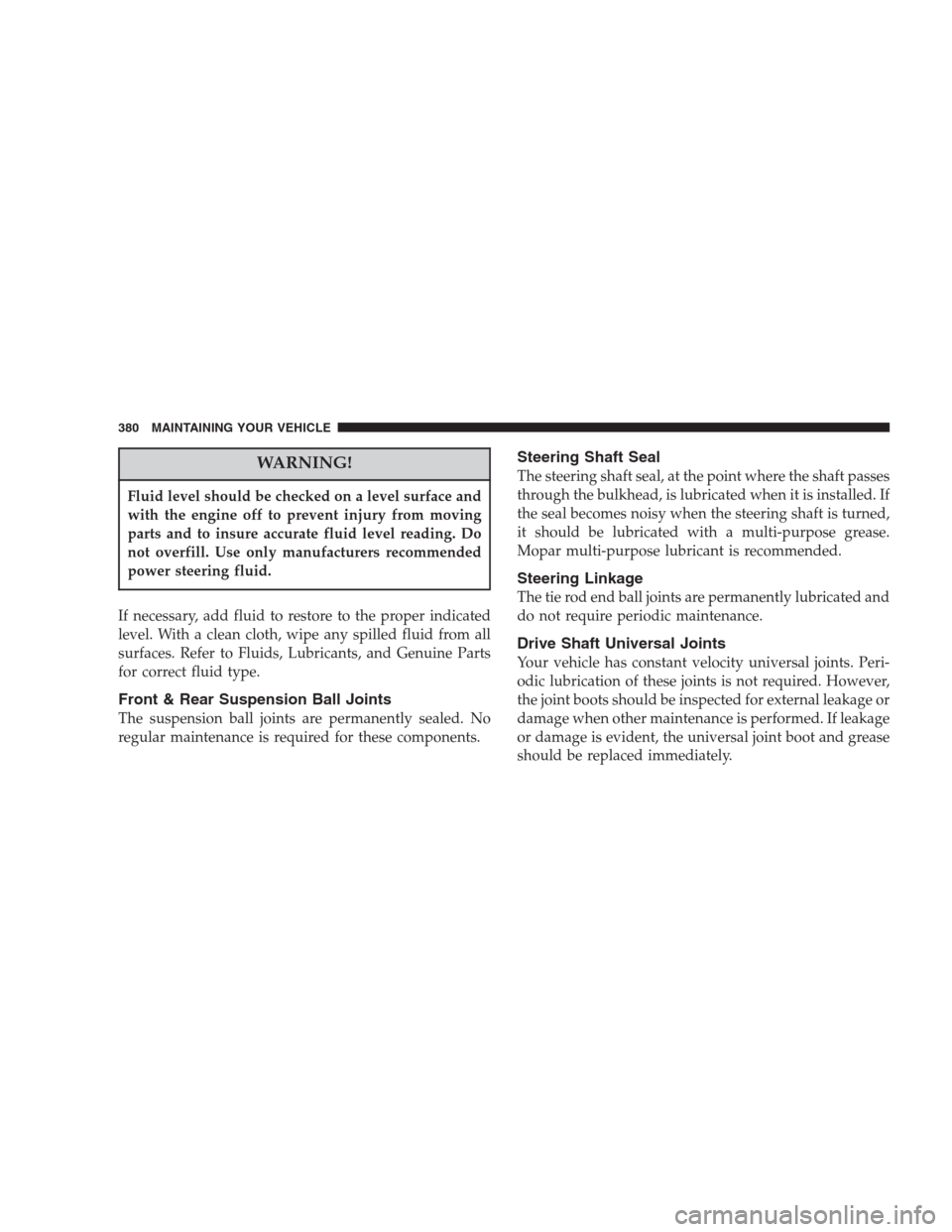Page 337 of 464

WARNING!
Improper towing can lead to an injury accident.
Follow these guidelines to make your trailer towing
as safe as possible:
Make certain that the load is secured in the trailer
and will not shift during travel. When trailering
cargo that is not fully secured, dynamic load shifts
can occur that may be difficult for the driver to
control. You could lose control of your vehicle and
have an accident.
•When hauling cargo or towing a trailer, do not over-
load your vehicle or trailer. Overloading can cause a
loss of control, poor performance or damage to brakes,
axle, engine, transmission, steering, suspension, chas-
sis structure or tires.
•Safety chains must always be used between your
vehicle and trailer. Always connect the chains to the
frame or hook retainers of the vehicle hitch. Cross the
chains under the trailer tongue and allow enough
slack for turning corners.
•Vehicles with trailers should not be parked on a grade.
When parking, apply the parking brake on the tow
vehicle. Put the tow vehicle automatic transmission in
P for Park. Always, block or�chock�the trailer wheels.
•GCWR must not be exceeded.
•Total weight must be distributed between the tow
vehicle and the trailer such that the following four
ratings are not exceeded:
1. GVWR
2. GTW
3. GAWR
STARTING AND OPERATING 337
5
Page 356 of 464

WARNING!
Do not connect the cable to the negative post of the
discharge battery. The resulting electrical spark
could cause the battery to explode.
During cold weather when temperatures are below
freezing point, electrolyte in a discharged battery
may freeze. Do not attempt jump starting because
the battery could rupture or explode. The battery
temperature must be brought up above freezing
point before attempting jump start.
6. Start the engine in the vehicle which has the booster
battery, let the engine idle a few minutes, then start the
engine in the vehicle with the discharged battery.
7. When removing the jumper cables, reverse the above
sequence exactly. Be careful of the moving belts and fan.
WARNING!
Any procedure other than above could result in:
1. Personal injury caused by electrolyte squirting
out the battery vent;
2. Personal injury or property damage due to battery
explosion;
3. Damage to charging system of booster vehicle or
of immobilized vehicle.
FREEING A STUCK VEHICLE
If your vehicle becomes stuck in mud, sand or snow, it
can often be moved by a rocking motion. Turn your
steering wheel right and left to clear the area around the
front wheels. Then shift back and forth between Reverse
and Drive. Usually the least accelerator pedal pressure to
maintain the rocking motion without spinning the
wheels is most effective.
356 WHAT TO DO IN EMERGENCIES
Page 361 of 464
MAINTAINING YOUR VEHICLE
CONTENTS
�4.0L Engines..........................364
�3.8L Engines..........................365
�Onboard Diagnostic System — OBD II........366
▫Loose Fuel Filler Cap Message............366
�Emissions Inspection And Maintenance
Programs............................367
�Replacement Parts......................368
�Dealer Service.........................369
�Maintenance Procedures..................369▫Engine Oil..........................369
▫Engine Oil Filter......................374
▫Drive Belts — Check Condition And Tension . . 374
▫Spark Plugs.........................374
▫Engine Air Cleaner Filter................374
▫Catalytic Converter....................375
▫Maintenance-Free Battery................376
▫Air Conditioner Maintenance.............378
▫Power Steering — Fluid Check............379
7
Page 362 of 464

▫Front & Rear Suspension Ball Joints........380
▫Steering Shaft Seal....................380
▫Steering Linkage......................380
▫Drive Shaft Universal Joints..............380
▫Body Lubrication.....................381
▫Windshield Wiper Blades................381
▫Windshield And Rear Window Washers.....382
▫Exhaust System......................382
▫Cooling System.......................383
▫Hoses And Vacuum/Vapor Harnesses.......388
▫Brakes.............................389
▫Master Cylinder — Brake Fluid Level Check . . 390
▫Fuel System Hoses....................391▫Automatic Transmission................392
▫All Wheel Drive (AWD) — If Equipped.....395
▫Front And Rear Wheel Bearings...........396
▫Appearance Care And Protection From
Corrosion...........................396
▫Cleaning The Center Console Cup Holders . . . 401
�Fuses (Integrated Power Module)...........402
�Vehicle Storage........................405
�Replacement Light Bulbs.................406
�Bulb Replacement......................406
▫Standard Quad Headlights...............406
▫High Intensity Discharge Headlights (HID) —
If Equipped.........................407
362 MAINTAINING YOUR VEHICLE
Page 379 of 464

Refrigerant Recovery And Recycling
R-134a Air Conditioning Refrigerant is a hydrofluorocar-
bon (HFC) that is endorsed by the Environmental Pro-
tection Agency and is an ozone-saving product. How-
ever, the manufacturer recommends that air conditioning
service be performed by dealers or other service facilities
using recovery and recycling equipment.
NOTE:Use only manufacturer approved A/C System
Sealers, Stop Leak Products, Seal Conditioners, Compres-
sor Oil, or Refrigerants.
A/C Air Filter
The filter access door is located under the instrument
panel on the passenger side. To replace the filter slide the
lock toward the rear of the vehicle (unlock position).
Remove the access door and pull the filter downward.
When installing a new filter, ensure its proper orienta-
tion. Align the black arrow on the bottom of the filterframe with the direction of airflow (away from the
blower motor and towards the center of the car).
Refer to the “Maintenance Schedules” section of this
manual for the recommended air conditioning filter
replacement intervals.
Power Steering — Fluid Check
Checking the power steering fluid level at a defined
service interval is not required. The fluid should only be
checked if a leak is suspected, abnormal noises are
apparent, and/or the system is not functioning as antici-
pated. Coordinate inspection efforts through a certified
DaimlerChrysler Dealership.�
MAINTAINING YOUR VEHICLE 379
7
Page 380 of 464

WARNING!
Fluid level should be checked on a level surface and
with the engine off to prevent injury from moving
parts and to insure accurate fluid level reading. Do
not overfill. Use only manufacturers recommended
power steering fluid.
If necessary, add fluid to restore to the proper indicated
level. With a clean cloth, wipe any spilled fluid from all
surfaces. Refer to Fluids, Lubricants, and Genuine Parts
for correct fluid type.
Front & Rear Suspension Ball Joints
The suspension ball joints are permanently sealed. No
regular maintenance is required for these components.
Steering Shaft Seal
The steering shaft seal, at the point where the shaft passes
through the bulkhead, is lubricated when it is installed. If
the seal becomes noisy when the steering shaft is turned,
it should be lubricated with a multi-purpose grease.
Mopar multi-purpose lubricant is recommended.
Steering Linkage
The tie rod end ball joints are permanently lubricated and
do not require periodic maintenance.
Drive Shaft Universal Joints
Your vehicle has constant velocity universal joints. Peri-
odic lubrication of these joints is not required. However,
the joint boots should be inspected for external leakage or
damage when other maintenance is performed. If leakage
or damage is evident, the universal joint boot and grease
should be replaced immediately.
380 MAINTAINING YOUR VEHICLE
Page 389 of 464

Inspect all hose connections such as clamps and couplings
to make sure they are secure and no leaks are present.
Components should be replaced immediately if there is
any evidence of wear or damage that could cause failure.
Brakes
In order to assure brake system performance, all brake
system components should be inspected periodically.
Suggested service intervals can be found in the Mainte-
nance Schedules.
WARNING!
Riding the brakes can lead to brake failure and
possibly an accident. Driving with your foot resting
or riding on the brake pedal can result in abnormally
high brake temperatures, excessive lining wear, and
possible brake damage. You wouldn’t have your full
braking capacity in an emergency.
Brake And Power Steering Hoses
When the vehicle is serviced for scheduled maintenance,
inspect surface of hoses and nylon tubing for evidence of
heat and mechanical damage. Hard and brittle rubber,
cracking, tears, cuts, abrasion, and excessive swelling
indicate deterioration of the rubber. Particular attention
should be made to examining those hose surfaces nearest
to high heat sources, such as the exhaust manifold.
Insure nylon tubing in these areas has not melted or
collapsed.
Inspect all hose connections such as clamps and cou-
plings to make sure they are secure and no leaks are
present.
NOTE:Often, fluid such as oil, power steering fluid,
and brake fluid are used during assembly plant opera-
tions to facilitate the assembly of hoses to couplings.
Therefore, oil wetness at the hose-coupling area is not
necessarily an indication of leakage. Actual dripping of
MAINTAINING YOUR VEHICLE 389
7
Page 413 of 464
Chassis
Component Fluids, Lubricants and Genuine Parts
Automatic Transmission Mopar�ATF+4 Automatic Transmission Fluid.
AWD Power Transfer Unit Mopar�Gear Lubricant 75W-90 or equivalent.
AWD Rear Carrier Mopar�Gear Lubricant 75W-90 or equivalent.
Brake Master Cylinder Mopar�DOT 3 and SAE J1703 should be used. Use only recommended
brake fluids.
Power Steering Reservoir Mopar�Power Steering Fluid +4 or Mopar�ATF +4 Automatic Transmis-
sion Fluid.
MAINTAINING YOUR VEHICLE 413
7